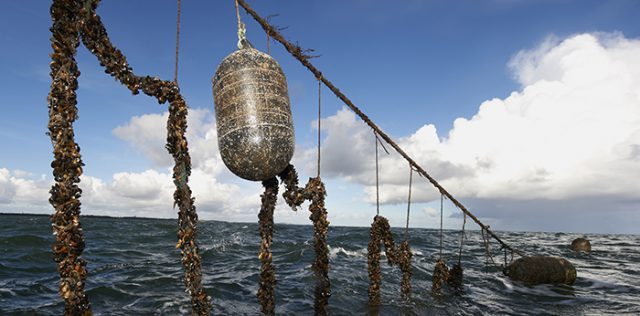The need for organic protein sources for animal feed for Danish organic livestock production is expected to see a further increase, when EU requirements from 2018 stipulate that all feed for organic livestock production must be 100% organic.
Mussel farming targeted at nutrient removal differs from mussel farming for the dinner table, as the farmers do not focus on producing large mussels, but rather achieving as high a filtering biomass per area and binding of as many nutrients as possible.
The result is far more, but far smaller mussels that are too small for the supermarket cold counter, but which can be a valuable source of protein for, e.g., organic poultry or pigs.
A project by the Technical University of Denmark (DTU) Aqua, with funds from the Innovation Fund Denmark, will study the water-purifying effect of mussel farming in different Danish fjord systems.
It will also develop models for the management of increasing mussel production in coastal waters—with special focus on models for valuation and payment of ecosystem services as well as for the use of the coastal zone.
The joined efforts must make it possible to determine whether mussel farming can be included in third-generation water plans.
The MuMiPro (Mussel farming, Mitigation and Protein Source for organic husbandry) project has a total budget of DKK 21 million (US$2.97 million) and is headed by Jens Kjerulf Petersen, Danish Shellfish Centre, DTU Aqua.
“With MuMiPro, we get a ‘Kinder Surprise Egg’ in the form of a project which can both deliver a water treatment solution to ailing Danish fjords, sustainably produced protein sources to organic livestock production, and job creation in areas outside of the big cities,” says Petersen.
The project aims to provide the knowledge base for an annual production of up to 100,000 tons of mussels—corresponding to 15,000 tons of organic feed ingredients—within six to 10 years.
This means removal of 1-2,000 tons of nitrogen, or 8%-15% of the current needs (2014).
The innovation project is a collaboration between DTU (Aqua and Food), Aarhus University (BIOS, ANIS, ENV, and FOOD), Seafood Limfjord, Wittrup Seafood, Vilsund Blue, Engredo, Nofima, the Limfjord Council, Danish Agro, SEGES, and Udviklingscenter for Husdyr på Friland (livestock development center).
Story by Line Reeh from the Technical University of Denmark










